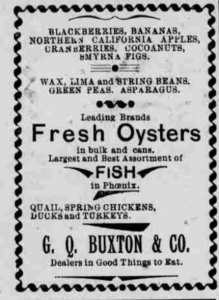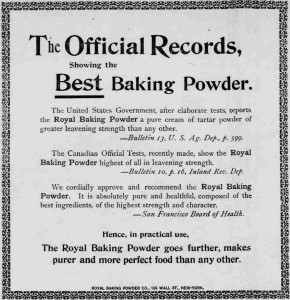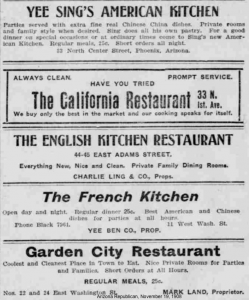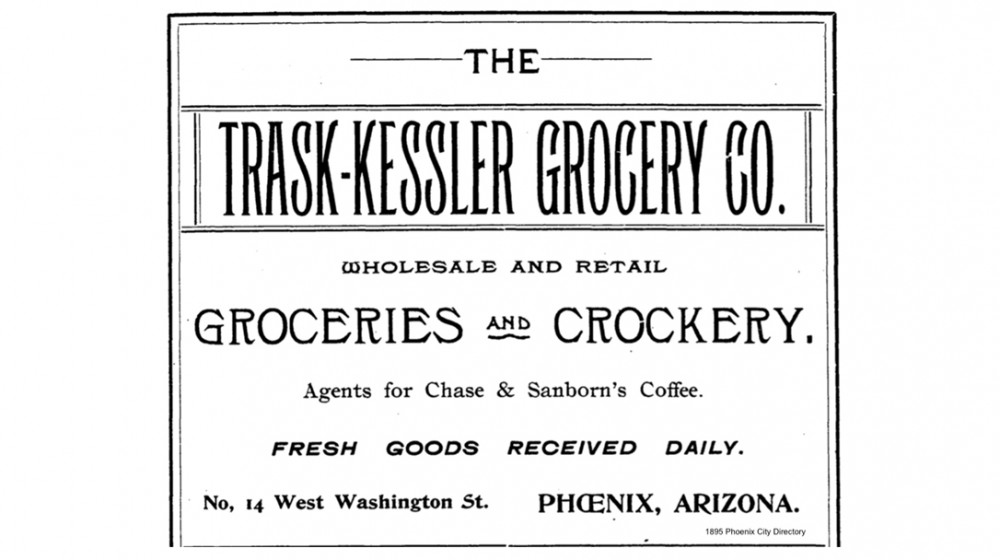Victorian Food (à la 1977)
Did you know…
 The Rossons may have lived in Phoenix over a century ago, but they didn’t exactly have to rough it out here in the “wild west.” Any visitor to the Museum knows the residents of this lovely home enjoyed the modern conveniences of electricity, a telephone, and (thank heavens) indoor plumbing that included hot and cold running water and a toilet. They also had their pick of grocery stores, markets, mercantiles, wholesalers, and other places to purchase their food. For more information on that subject, here is a copy of a speech (edited for clarity) given by Eugene Parker of the Associated Grocers, to attendees of the Phoenix History Conference on October 15, 1977.
The Rossons may have lived in Phoenix over a century ago, but they didn’t exactly have to rough it out here in the “wild west.” Any visitor to the Museum knows the residents of this lovely home enjoyed the modern conveniences of electricity, a telephone, and (thank heavens) indoor plumbing that included hot and cold running water and a toilet. They also had their pick of grocery stores, markets, mercantiles, wholesalers, and other places to purchase their food. For more information on that subject, here is a copy of a speech (edited for clarity) given by Eugene Parker of the Associated Grocers, to attendees of the Phoenix History Conference on October 15, 1977.
-
The Food Industry in Phoenix in 1895
“In 1895, the Rossons would not have shopped for groceries as we do now. The selection of items was not great and packaging was just beginning to take hold. Frozen foods were unknown, ice cream was available only at the ice cream parlor or home made, and refrigerated foods, as we know them, were not carried in the grocery store. Many items were available only in the local season as transportation and growing seasons throughout the country, had not been improved to where they are today. All stores in that period would have closed had they been required to meet the FDA sanitation standards of today. In fact they probably would not have been able to get supplies. Transportation, a most important factor in the food business, was in the stage that horses and wagons or railroads were all that was available.
The Rossons had a good selection of stores from which to choose, considering the population of Phoenix in 1895 was only 3,000. These stores would have had shelves along the wall, and counters behind which clerks would work. There was no self-service – instead, the clerk brought everything to you. This was the day of the individual merchant. In the 1880s, E.F. Kellner had a cash store at 1st Street and Washington with a big sign that said, “Will not be undersold.”
Grocery merchandising certainly hasn’t changed much. Chapman Brothers promised goods promptly delivered at lowest cash prices. The Tribolet-Budge Meat Company had pork, lard, hams, salted and corned meats, poultry, game, and fresh fish. They boasted the only cold air storage in Arizona, which meant that all the others used ice for refrigeration. Louis Melczer sold wines, liquors and cigars at wholesale. Later the Melczer family was in the wholesale grocery business until bought out by the Arizona Grocery Company. Trask-Kessler Grocery Company advertised wholesale-retail groceries, crockery, queensware, stoneware, and glassware. J.A. Lutgerding and Company had fresh and salt meats, mutton, pork, veal and poultry. They advertised it was refrigerated before delivery. This would mean putting it on ice. The Phoenix Bakery had recently been renovated and had free delivery to any part of the city. The Washington Market, owned by Mr. Tovrea, advertised steaks – “We butcher only the best.” Charley Donofrio who had been here for about 8 years and had just opened a store at 44 North Central. His motto was, “Prompt delivery.” Shortly later Charley’s brother from Italy, Sam Donofrio, opened a grocery store at 2nd Street and Jackson in a new brick building with an assortment of groceries, confectioneries, cigars, and tobacco. He also had delivery wagons. D.T. Ramberg had a grocery at 311 West Washington. One store mentioned best cash prices, but it was customary to give credit as well as deliver.
Many of the products carried by these stores and markets were handled in bulk, and included beans; sugar, coffee, tea, cocoa, rice, crackers, cookies, flour, and eggs. Incidentally, eggs were 15 cents per dozen, and, like many products, were taken in trade from customers of the store, and resold to other customers.
The 1890s and early 1900s saw a great increase in packaged foods. This was the period of the start of ready-to-eat cereals such as Shredded Wheat, Grapenuts, and Kelloggs, as well as the Uneeda biscuit in a 5 cent package. Other packaged and branded items that were handled were Babbitt’s Lye, Burnett’s Vanilla, Royal Baking
 Powder, Eagle Brand Milk, Quaker Oats, Hires Root Beer, None-such Mince Meat, Fletchers Castoria, and Robert Burns Cigars. The Capital Mills on East Adams Street supplied Gardners Best Flour, and Mesa had just completed a 40-barrel flourmill. However, the leading seller was probably flour from Hayden Mills in Tempe. Hayden’s delivered their flour on flat bed wagons pulled by 2 horses, both in town and as far away as Globe. A new local industry was the Arizona Soap Company, and all grocers were carrying their products. The creamery at Tempe was turning out 3,000 – 5,000 pounds of butter a month; however, during the summer they made cheese rather than butter, as it was easier to hold in good condition.
Powder, Eagle Brand Milk, Quaker Oats, Hires Root Beer, None-such Mince Meat, Fletchers Castoria, and Robert Burns Cigars. The Capital Mills on East Adams Street supplied Gardners Best Flour, and Mesa had just completed a 40-barrel flourmill. However, the leading seller was probably flour from Hayden Mills in Tempe. Hayden’s delivered their flour on flat bed wagons pulled by 2 horses, both in town and as far away as Globe. A new local industry was the Arizona Soap Company, and all grocers were carrying their products. The creamery at Tempe was turning out 3,000 – 5,000 pounds of butter a month; however, during the summer they made cheese rather than butter, as it was easier to hold in good condition.Not everything was handled through the stores, as those were the days of the horse drawn vegetable wagons. On May 30, 1895, one of these vegetable wagons was going down 2nd Street when the horse ran away and demolished the wagon and contents against a large cottonwood tree. The driver was not hurt. The Salt River Valley Produce Company carried fresh vegetables and fruits, and on May 30 was featuring asparagus and rhubarb from Prescott, and spring chickens. In the summer of 1895 about fifty carloads of apricots were shipped out of the valley bringing as much as 16 cents per pound, while at times they sold for ½ cent per pound on the tree. Local strawberries as large as apricots were also featured. A Flagstaff newspaper complained that the Salt River Valley was not supplying them with enough fruits and vegetables, forcing them to look to the coast or Albuquerque for supplies. It is interesting that the rail schedule for transporting these products from Phoenix to Flagstaff was delivery on the evening of the second day after leaving Phoenix. (The Santa Fe completed their tracks from the north to Phoenix in February, 1895.) During the summer at least one carload of honey, and a number of carloads of grapes were shipped to Chicago. Also, a carload of hogs was shipped to El Paso.
There was
 quite a selection of restaurants available if the grocery “vittles” were not satisfactory. Among these were the Palace Chop House, Jim Sam Restaurant, the New Delmonico Restaurant, Garden City Restaurant (with a swimming pool!), Ivy Green Restaurant, New Nickel Plate Restaurant, which advertised as one of the, “Best short order houses – pure cream in the coffee has done it,” and The Model, which advertised, “Why pay 25 cents for a meal when you can get one for 15 cents?” In a newspaper note the Link Restaurant closed July 27th, 1895, to the great regret of those having meal tickets on the institution. Instead of giving credit, it was the custom then to sell books of meal tickets paid for in advance, so the closing left some people holding the bag. Another big event, “The Trilby has placed a new revolving ceiling fan in operation.” Murrays Ice Cream Parlor, while not a restaurant, was quite well patronized. June 27th an ice cream social was held at the Salvation Army tent, admittance 15 cents. Most stores, restaurants, and markets used ice for some refrigeration, and quite a few homes had iceboxes where they kept milk, butter, meat, etc. They all were temporarily endangered in the summer of 1895 when the Arctic Ice Company, putting out 23 tons per day, broke down. It took only several days to get operating again, but this could have been a calamity!
quite a selection of restaurants available if the grocery “vittles” were not satisfactory. Among these were the Palace Chop House, Jim Sam Restaurant, the New Delmonico Restaurant, Garden City Restaurant (with a swimming pool!), Ivy Green Restaurant, New Nickel Plate Restaurant, which advertised as one of the, “Best short order houses – pure cream in the coffee has done it,” and The Model, which advertised, “Why pay 25 cents for a meal when you can get one for 15 cents?” In a newspaper note the Link Restaurant closed July 27th, 1895, to the great regret of those having meal tickets on the institution. Instead of giving credit, it was the custom then to sell books of meal tickets paid for in advance, so the closing left some people holding the bag. Another big event, “The Trilby has placed a new revolving ceiling fan in operation.” Murrays Ice Cream Parlor, while not a restaurant, was quite well patronized. June 27th an ice cream social was held at the Salvation Army tent, admittance 15 cents. Most stores, restaurants, and markets used ice for some refrigeration, and quite a few homes had iceboxes where they kept milk, butter, meat, etc. They all were temporarily endangered in the summer of 1895 when the Arctic Ice Company, putting out 23 tons per day, broke down. It took only several days to get operating again, but this could have been a calamity!Some of the non-food products handled by grocery stores were the, “Patent Medicines,” popular at the time. Though their names claimed otherwise, they were not truly patented, as the owners did not wish to put their secret formulas on record. Among the braded items were Lydia Pinkhams Vegetable Compound (containing 18% alcohol), Dr. Jayne Sanative Pills (for biliousness and liver complaints), Jayne’s Vermifuge (to expel parasitic worms), Parker’s Tonic (for coughs, asthma and consumption), Perrin’s Fumigator (for sore throats, loss of voice and catarrh), Dr. Townsley’s Toothache Anodyne (cures in one minute), and many others. Profits were very good on these items, and they were supposed to cure just about anything – take one dose for a man, and two for a horse! In a mail-order catalogue of 1905, twenty pages were devoted to such remedies. The Federal Food and Drug Act of 1906 changed much of that. (Thank goodness!)”
Archive
-
2025
-
January (1)
-
-
2024
-
December (1)
-
November (1)
-
October (1)
-
September (1)
-
August (1)
-
July (1)
-
June (1)
-
May (1)
-
April (1)
-
March (1)
-
February (1)
-
January (1)
-
-
2023
-
December (1)
-
November (1)
-
October (1)
-
September (1)
-
August (1)
-
July (1)
-
June (1)
-
May (1)
-
April (1)
-
March (1)
-
February (1)
-
January (1)
-
-
2022
-
December (1)
-
November (1)
-
October (1)
-
September (1)
-
August (1)
-
July (1)
-
June (1)
-
May (1)
-
April (1)
-
-
2021
-
December (1)
-
November (1)
-
October (1)
-
September (1)
-
August (1)
-
July (1)
-
June (1)
-
May (1)
-
April (1)
-
March (1)
-
February (1)
-
January (1)
-
-
2020
-
December (1)
-
November (1)
-
October (1)
-
September (1)
-
August (1)
-
July (1)
-
June (1)
-
May (1)
-
April (1)
-
March (1)
-
February (1)
-
January (1)
-
-
2019
-
December (1)
-
November (1)
-
October (1)
-
September (1)
-
August (1)
-
July (1)
-
June (1)
-
May (1)
-
April (1)
-
March (1)
-
February (1)
-
January (1)
-
-
2018
-
December (1)
-
November (1)
-
October (1)
-
September (1)
-
August (1)
-
July (1)
-
May (1)
-
April (1)
-
March (1)
-
February (1)
-
January (1)
-
-
2017
-
December (1)
-
November (1)
-
October (1)
-
September (1)
-
August (1)
-
July (1)
-
June (1)
-
May (1)
-
April (1)
-
March (1)
-
February (1)
-
-
2016
-
December (1)
-
-
2015
-
2014
-
July (1)
-
